
Near the end of the last Ice Age 8,000 years ago, an ice dam on North America's east coast broke, releasing a torrent of fresh water seven times more voluminous than all the Great Lakes combined. It all rushed into the Atlantic Ocean over the course of only a few months.
At around the same time, ocean circulation worldwide slowed to a crawl, plunging Europe into a second ice age that lasted centuries.
Scientists have long suspected the two events were linked, and now they have the evidence from sediment core samples to prove it.
The finding, detailed in the June 30 issue of the journal Science, provides the first clear evidence that the so-called North American "lake burst" was the trigger that slowed ocean circulation and cooled the climate about 8,200 years ago.
Shell chemistry
The researchers studied a sediment core taken from the North Atlantic seabed south of Iceland. By analyzing the chemistry of shells belonging to microscopic sea creatures called foraminifera which were embedded in the core, they estimated the salinity of the seawater at different time points.
Also, by analyzing the size of sediment grains, the researchers were able to estimate the speed of deep ocean currents along the ocean bottom. More large particles there means that ocean currents were moving faster when the sediment layer was formed.
Sign up for the Live Science daily newsletter now
Get the world’s most fascinating discoveries delivered straight to your inbox.
These two pieces of evidence showed that as ocean salinity decreased, ocean currents slowed. Normally, ocean currents function like a global conveyer belt, ferrying warm, buoyant water from the southern hemisphere into the far north, where it loses its heat and sinks to the bottom because cold water is denser than warm water. The cold water is then ferried back towards the southern hemisphere along ocean currents on the bottom of the seafloor and the entire cycle repeats.
When the lake bursts occurred, the rapid influx of freshwater diluted the seas. Freshwater is more buoyant than seawater and does not sink as quickly. As the ocean became less salty, chilled water in the northern hemisphere took longer to sink, and the entire ocean circulation slowed down.
"It didn't switch it off completely; it just made it less intense," explained study team member Mark Chapman, also of the University of East Anglia.
For reasons that are still unclear, ocean salinity and circulation returned to normal after about two hundred years.
Future Implications
The ancient lake bursts event could also have implications for future climate change, scientists say.
"The impact of large-scale pulsed inputs of freshwater on ocean circulation and climate during the time of the last Ice Age are well documented, but our results clearly demonstrate that these sorts of abrupt reorganizations also can occur during periods of warm climate," said study leader Ian Hall of Cardiff University.
In the movie "An Inconvenient Truth," Al Gore mentions the North American lake bursts event and the stalling of the ocean currents. If large parts of Greenland and Antarctica were to melt as some global warming models predict, a similar stalling of the world's ocean currents could occur, Gore said.
But Chapman says that caution is needed when using past events to predict future climate changes.
"I think you have to be a little bit careful. It's not just the volume of water; it's how quickly they enter the system," Chapman told LiveScience.
In their study, Chapman and his colleagues estimated that the lake bursts released the equivalent of seven times the volume of all the Great Lakes combined into the ocean within about six months to a year.
"We don't really know what will happen if we have that same amount of water and, instead of having it released over a matter of months or a year or so, it was released over decades or a century" as global warming scenarios predict for the melting of Greenland, Chapman said.









